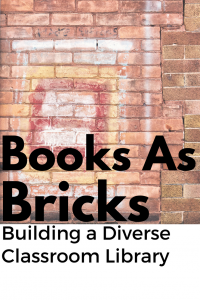Last week, Tu Books Publisher Stacy Whitman spoke at the Kansas Association of Teachers of English (KATE) conference about why and how to use diverse books in the classroom. In this blog post, we share some highlights from her presentation that may be helpful for readers across the country.
Why do we need diverse books?
First, we started out with Chimamanda Ngozi Adichie’s excellent TED talk “The Danger of a Single Story,” which kicked off our discussion of why diverse books are important for all our students.
Next, we discussed this excellent article from NCTE by Lorna Collier, in which educators discuss the impact of using diverse books in the classroom. For example, eighth-grade teacher Karimah Tennyson-Marsh decided to use diverse books in her diverse classroom (80 percent Latino, 20 percent African American) and found that the books helped to improve classroom performance: “Her class’s most recent test scores (from the 2015/2016 school year) show 46 percent of her students are meeting or exceeding standards for reading—up from 36 percent the previous year.”
Once we understand why diverse books are important, where do we find them?
Reviewers and awards
Here are reviewers to watch (and make sure to follow their Twitter, Tumblr, and Facebook pages as well!):
American Indians in Children’s Literature
I’m Here. I’m Queer. What the Hell Do I Read?
We also discussed the We Need Diverse Books app, which will be coming in January. Can’t wait? Check out their Tumblr for book lists, particularly their Summer Reading Series for recommendations.
Also be sure to check out book lists from the American Library Association’s annual awards, including their ethnic awards (Coretta Scott King, Pura Belpré, Asian Pacific American Library Association, and American Indian Youth Literature awards) for more excellent diverse book lists.
Lee & Low Resources for Educators
The Open Book: The Lee & Low Books blog (where you currently find yourself!) is an excellent resource for educators, regularly covering topics such as Diversity, Race, and Representation; Educator Resources; Book Lists by Topic; and more.
Specific book pages: on every book page, we link to examples of our nonprofit and literacy partners using our books (such as an educator’s guide from Vamos a Leer on the Summer of the Mariposas page and the Coretta Scott King discussion guide on the Yummy page). You can also find reviews for the books, links to audio-visual supplements, links to collections the book is in (by topic/CCSS theme), and more! Explore the site and find many brilliant books for any classroom.
Lee & Low Books on Pinterest: Looking for book lists broken down by CCSS theme, topic, age group, and more? Follow us on Pinterest!
Don’t Forget the Professional Value of Social Media
Our Tu Books and Lee & Low Twitter pages are constantly discussing diverse books, educational resources, and more. Follow us there and on Facebook:
You can also find like-minded advocates for diverse books via links from our social media pages.
How do I pay for these books?!
In an age where funding for schools is being cut back further and further, we understand it can be hard to find the budget to afford new books. Fortunately, there are ways to find the money.
Some teachers write their own grants. Here’s a guide to the process from the National Education Association.
Make your money go farther. First Book is a non-profit that provides low-cost books to schools, libraries, shelters and clinics, early childhood programs, and other organizations that serve children in need.
Crowd-fund. Have a specific project in mind? There are multiple platforms like Donors Choose that allow teachers to post a project (for example, a list of books for a classroom or school library), and donors help to make that goal possible. (If you do decide to crowd-fund, create your project and then tweet to us and to @leeandlow! We love to signal-boost projects for schools seeking to acquire diverse books.)
Book Recommendations
Here are a few diverse YA titles from Tu Books ripe for classroom use and discussion:
Shame the Stars, by Guadalupe García McCall
This historical fiction novel uses primary sources, poetry, and Shakespearean inspiration to tell the story of two star-crossed lovers in Texas during the explosive years of Mexico’s revolution.
Summer of the Mariposas, by Guadalupe García McCall
This retelling of The Odyssey pits five sisters against supernatural forces on a journey through Mexico.
Killer of Enemies, by Joseph Bruchac
This post-apocalyptic thriller by renowned Abenaki author Joseph Bruchac imagines the place of Native Americans in a future free of technology.
What other resources do you use to build diverse libraries for your school? Share below in the comments!











